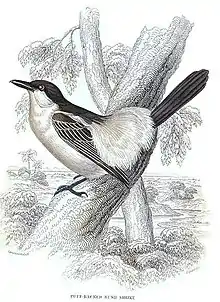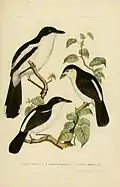| Dryoscopus | |
|---|---|
 | |
| Displaying D. gambensis male | |
| Scientific classification | |
| Domain: | Eukaryota |
| Kingdom: | Animalia |
| Phylum: | Chordata |
| Class: | Aves |
| Order: | Passeriformes |
| Family: | Malaconotidae |
| Genus: | Dryoscopus F. Boie, 1826 |
| Type species | |
| Lanius cubla[1] Latham, 1801 | |
Dryoscopus is a genus of bird in the Malaconotidae or bushshrike family. Its members are known as puffbacks. The six species, all of fairly uniform appearance and habits, are native to various parts of sub-Saharan Africa.[2] The name Dryoscopus is a compound Greek word: drus from the Greek word for "tree" and skopos, meaning "watcher or lookout".[3]
Structure and habits
Puffbacks are small, active bushshrikes that show a superficial resemblance to boubous. They however display only rudimentary duetting, have red or reddish irides, are smaller and compact with bouncy flight, and display sexual dimorphism.[4] Characteristically, the long, loose and pale feathers of the male bird's back and rump are puffed out conspicuously during display. At the same time he may fly about, calling loudly.[5] Comparable habits are found in some related genera (cf. Bocagia, Bias, Lanioturdus, Batis and Dyaphorophyia).[6]

They move about in pairs in the upper strata of trees (Pringle's excepting) and may join mixed-species flocks.[5] They command a varied repertoire of explosive and fricative whistles, percussive clicking sounds, and harsh rasping, churring or tearing sounds.[6] Three species have a rasping alarm call (cubla, senegalensis and pringlii), while the remaining three (gambensis, angolensis and sabini) have a stuttering alarm call. Wing fripping and bill snapping complement vocal communication. The nest is a neat compact cup in the general fashion of bushshrikes, but similar to those of shrike-flycatchers. Courtship feeding is present, and studied species are monogamous and single-brooded.
Relationships
DNA-DNA hybridization studies suggest that genus Tchagra is their closest relative, though biological traits also link them to Laniarius, shrike-flycatchers (i.e. Bias and Megabyas) and other genera.[6]
Species
The genus contains the following six species:[7]
| Image | Common Name | Scientific name | Habitat | Distribution |
|---|---|---|---|---|
 | Pink-footed puffback | Dryoscopus angolensis | isolated montane and submontane forests | Kenya, Uganda and the eastern Congo Basin |
 | Black-backed puffback | Dryoscopus cubla | tropical to austral woodlands and afromontane forest | sub-Saharan Africa, from southern Somalia to coastal South Africa. |
%252C_crop.jpg.webp) | Northern puffback | Dryoscopus gambensis | equatorial to sub-Saharan wooded savannah | northern sub-Saharan Africa |
| Pringle's puffback | Dryoscopus pringlii | dry, equatorial acacia scrub and thicket | Ethiopia, Kenya, Somalia, and northern Tanzania | |
 | Sabine's puffback | Dryoscopus sabini | tropical forest | Congo basin and West African coast |
| Red-eyed puffback | Dryoscopus senegalensis | mid-canopy at tropical forest edge and clearings[4] | Nigeria and Central Africa. | |
Gallery
_(6017632158).jpg.webp) Head of male, D. cubla, showing red iris
Head of male, D. cubla, showing red iris_(31638418377)%252C_crop.jpg.webp) Displaying male, D. cubla, with raised back and rump feathers
Displaying male, D. cubla, with raised back and rump feathers_male_(32397227986).jpg.webp) Tit-like foraging habit of male D. cubla
Tit-like foraging habit of male D. cubla_(14749479424).jpg.webp) Nest of D. cubla wedged in branches of a sapling
Nest of D. cubla wedged in branches of a sapling
References
- ↑ "Malacontidae". aviansystematics.org. The Trust for Avian Systematics. Retrieved 2023-07-16.
- ↑ Monroe, Jr., Burt L.; Sibley, Charles G. (1997). A World Checklist of Birds. New Haven, CT, USA: Yale University Press. pp. 213–4. ISBN 978-0-300-07083-5.
- ↑ Jobling, James A. (2010). The Helm Dictionary of Scientific Names. London, UK: Christopher Helm. p. 141. ISBN 978-1-4081-2501-4.
- 1 2 Sinclair, Ian; Ryan, Peter (2010). Birds of Africa south of the Sahara (2nd ed.). Cape Town: Struik Nature. pp. 580–581. ISBN 9781770076235.
- 1 2 Terry Stevenson; John Fanshawe (2004). Birds of East Africa: Kenya, Tanzania, Uganda, Rwanda, Burundi. Helm Field Guides. p. 472. ISBN 0713673478.
- 1 2 3 Harris, Tony; Franklin, Kim (2000). Shrikes & bush-shrikes: including wood-shrikes, helmet-shrikes, flycatcher-shrikes, philentomas, batises and wattle-eyes. London: C. Helm. pp. 35–46. ISBN 9780713638615.
- ↑ "ITIS Report: Dryoscopus". Integrated Taxonomic Information System. Retrieved 20 October 2014.